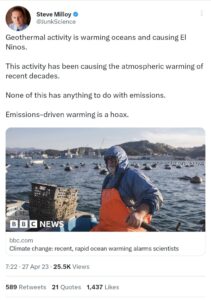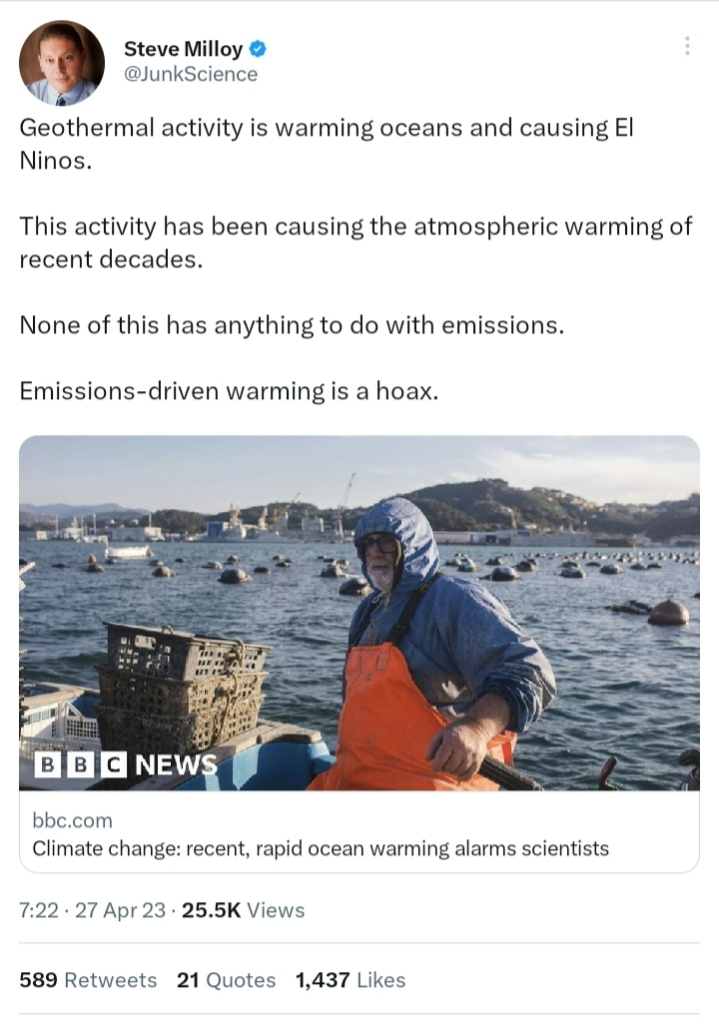Physical Address
23,24,25 & 26, 2nd Floor, Software Technology Park India, Opp: Garware Stadium,MIDC, Chikalthana, Aurangabad, Maharashtra – 431001 India
Physical Address
23,24,25 & 26, 2nd Floor, Software Technology Park India, Opp: Garware Stadium,MIDC, Chikalthana, Aurangabad, Maharashtra – 431001 India

Claim: Geothermal activities are causing the rise in ocean temperature and atmospheric warming and Emissions driven warming is a hoax.
Fact: Misleading. There is various scientific evidence to show that increasing greenhouse gas emissions have resulted in the warming of the oceans.
Claim post:

What does the post say
A Twitter post by climate science contrarian Steve Milloy, dated April 27, 2023, went viral with a tagged BBC article. The post claims that Geothermal activities are the reason behind the warming of oceans and causing EL ninos in recent decades and such effects have nothing to do with the Emissions. The post also mentions that “Emissions-driven warming is a hoax.”
What we found
The post is Misleading. The BBC article tagged in the tweet is about the impacts of ocean warming and the concerns of the scientists who are worried about the rising temperature of the ocean and its impact on other weather effects such as El Nino etc, the claim made by the climate denier Steve Milloy is nowhere related to the BBC article. It is mentioned in the article that scientists don’t fully understand why this rapid global sea surface hits a new record high temperature. The claim made by the post that Geothermal activity is raising the ocean temperature and it has nothing to do with Emissions is false information. There is various scientific evidence to show that increasing greenhouse gas emissions have resulted in the warming of the oceans, they absorb 25% of all CO2 emissions and capture 90 percent of the excess heat generated by these emissions.
World’s Ocean: The planet’s greatest carbon sink
According to UN Climate Change, the ocean has long borne the brunt of the consequences of man-made global warming. The ocean, as the world’s largest carbon sink, absorbs excess heat and energy trapped in the Earth’s system as a result of rising greenhouse gas emissions. Today, the ocean has absorbed roughly 90% of the heat that results from rising emissions. As excess heat and energy warm the ocean, the temperature change causes unprecedented escalating repercussions such as ice melting, sea-level rise, marine heat waves, and ocean acidification.
The increased atmospheric concentrations of greenhouse gasses, primarily from the burning of fossil fuels, cause the ocean to absorb enormous amounts of heat. According to the IPCC’s Fifth Assessment Report, which was released in 2013, the ocean had absorbed more than 93% of the surplus heat from greenhouse gas emissions since the 1970s and the temperature of the ocean is rising as a result of it.
What is ocean heat and why does it matter?
More than 70% of the surface of our planet is covered by water, and water can absorb a lot of heat without significantly raising the temperature. The ocean plays a crucial part in maintaining the Earth’s climate system due to its extraordinary capacity to store and release heat over extended periods. The heat that the water absorbs moves from one area to another, but it doesn’t go away. The thermal energy eventually makes its way back into the rest of the Earth’s system through the melting of ice shelves, water evaporation, or direct reheating of the atmosphere. Because of this, thermal energy from the oceans can continue to warm the earth for years after it was absorbed.
As greenhouse gasses trap more solar energy, the oceans absorb more heat, resulting in higher sea surface temperatures and rising sea levels. Changes in ocean temperatures and currents caused by climate change will cause changes in global climate patterns. Warmer waters, for example, may stimulate the development of stronger storms in the tropics, causing property damage and loss of life. The consequences of rising sea levels and higher storm surges are especially significant to coastal populations.
These changes have a long-term impact on marine biodiversity and the lives and livelihoods of coastal communities and beyond, affecting approximately 680 million people who live in low-lying coastal areas, nearly 2 billion who live in half of the world’s coastal megacities, nearly half of the world’s population (3.3 billion) who rely on fish for protein, and nearly 60 million people who work in fisheries and the aquaculture sector globally.
Is the ocean warming the same everywhere?
The rate of ocean warming varies depending on depth and location in the world.
The South Atlantic, the western Tropical Pacific, the South-west Pacific, the North Pacific, and the South-west Indian Ocean, according to the Intergovernmental Panel on Climate Change (IPCC), are among the regions that would experience noticeably faster sea level rise.
While the entire ocean is warming, the surface down to about 10 feet is warming the fastest. In areas of the North Atlantic, Indian, Arctic, and Southern Oceans that are rapidly warming, glaciers and ice sheets are melting as a result of warmer ocean temperatures.
Freshwater changes the density of saltwater as polar ice melts into the ocean. Salty, cold water typically sinks, but when it’s fresher and warmer, it alters the heat distribution and ocean circulation patterns.
Uneven warming is also caused by the strong currents that transport and distribute heat throughout the ocean. These regions start to heat up when those currents transport warm water masses to deeper levels and cooler latitudes.
The large amount of Greenhouse gasses could make the warming far worse
Greenhouse gasses have preserved Earth’s temperature such that humans and millions of other species have been able to live there by trapping solar heat. However, those gasses are currently out of balance and risk significantly altering where and how living things can survive on this planet.
The most harmful and widespread greenhouse gas, carbon dioxide, is present in the atmosphere at the highest level ever seen.
Huge reserves of carbon dioxide and methane, which are thought to be buried in the form of climate time bombs, are being discovered by scientists all over the world’s ocean floors, and their fuses are blazing as well. The powerful greenhouse gasses are contained in hydrates, which are frozen caps of CO2 or methane that prevent them from escaping into the ocean or atmosphere. However, as carbon emissions increase, the ocean is warming, and some hydrate caps are reportedly just a few degrees away from dissolving due to the temperature of the seawater surrounding them.
That might be seriously detrimental. The most prevalent greenhouse gas, carbon dioxide, accounts for around 75 percent of emissions. It can last for thousands of years in the atmosphere. Natural gas’s primary component, methane, doesn’t linger in the atmosphere for as long as carbon dioxide (12 years), but over 20 years, it is at least 84 times more potent. With serious repercussions for climate change and sea level rise, the oceans run the risk of turning into major carbon emitters if rising seas melt hydrate caps.
Fact check story
By Vivek Saini
References